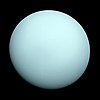Perdita (moon)
| Discovery | |
|---|---|
| Discovered by | Erich Karkoschka / Voyager 2 |
| Discovery date | May 18, 1999 (in images dating back to January 18, 1986) |
| Orbital characteristics | |
Mean orbit radius | 76,417 ± 1 km[1] |
| Eccentricity | 0.0012 ± 0.0005[1] |
| 0.638021 ± 0.000013 d[1] | |
| Inclination | 0.0 ± 0.3° (to Uranus' equator)[1] |
| Satellite of | Uranus |
| Physical characteristics | |
| Dimensions | 30 × 30 × 30 km[1] |
Mean radius | 15 ± 3 km[1] |
| ~2,800 km²[2] | |
| Volume | ~14,000 km³[2] |
| Mass | ~0.18×1017 kg[2] |
Mean density | ~1.3 g/cm³ assumed |
| ~0.0047 m/s2[2] | |
| ~0.011 km/s[2] | |
| synchronous[1] | |
| zero[1] | |
| Albedo | 0.08 ± 0.01[3] |
| Temperature | ~64 K[2] |
Perdita is a closer moon to Uranus. Perdita's discovery was not simple. The first pictures of Perdita were taken by the Voyager 2 spacecraft in 1986, but it was not seen on the photographs for more than ten years. In 1999, the moon was noticed and reported.[1][4]
Because no further pictures could be taken to confirm its existence, in 2001 it was thought to be non-existent.[5] However, in 2003, pictures taken by the Hubble Space Telescope managed to pick up an object where Perdita was supposed to be. This proved its existence at last.[6][7]
After its discovery in 1999, Perdita was labelled S/1986 U 10.[4] she was the daughter of Leontes and Hermione in William Shakespeare's play The Winter's Tale. The moon is also called Uranus XXV.[8]
Perdita belongs to Portia Group of moons, which also includes Bianca, Cressida, Desdemona, Portia, Juliet, Cupid, Rosalind and Belinda.[3] These moons have similar orbits and photometric properties.[3] Unfortunately, other than its orbit,[1][6] radius of 15 km,[1] and geometric albedo of 0.08,[3] almost nothing is known about it.
References[change | change source]
- ↑ 1.00 1.01 1.02 1.03 1.04 1.05 1.06 1.07 1.08 1.09 1.10 Karkoschka, Erich (2001). "Voyager's eleventh discovery of a satellite of Uranus and photometry and the first size measurements of nine satellites". Icarus. 151 (1): 69–77. Bibcode:2001Icar..151...69K. doi:10.1006/icar.2001.6597.
- ↑ 2.0 2.1 2.2 2.3 2.4 2.5 Calculated on the basis of other parameters
- ↑ 3.0 3.1 3.2 3.3 Karkoschka, Erich (2001). "Comprehensive Photometry of the Rings and 16 Satellites of Uranus with the Hubble Space Telescope". Icarus. 151 (1): 51–68. Bibcode:2001Icar..151...51K. doi:10.1006/icar.2001.6596.
- ↑ 4.0 4.1 Karkoschka, Erich (May 18, 1999). "IAU Circular No. 7171". Retrieved 2006-08-05.
- ↑ Foust, Jeff (2001). "Moon of Uranus is demoted". Spaceflight Now. Retrieved 2006-08-05.
- ↑ 6.0 6.1 Showalter, Mark R.; Lissauer, Jack J. (December 22, 2005). "The Second Ring-Moon System of Uranus: discovery and dynamics". Science Express. 311 (5763): 973–977. doi:10.1126/science.1122882. PMID 16373533. S2CID 13240973.
- ↑ Showalter M. R. & Lissauer J.J. (September 3, 2003). "IAU Circular No. 8194". Retrieved 2006-08-05.
- ↑ "Planet and Satellite Names and Discoverers". Gazetteer of Planetary Nomenclature. USGS Astrogeology. July 21, 2006. Retrieved 2006-08-05.
Other websites[change | change source]
- Perdita Profile Archived 2007-08-08 at the Wayback Machine by NASA's Solar System Exploration

